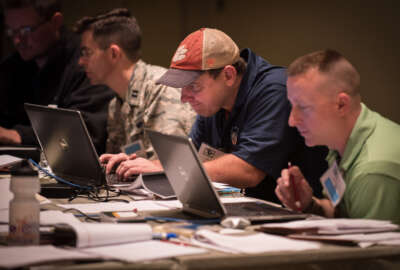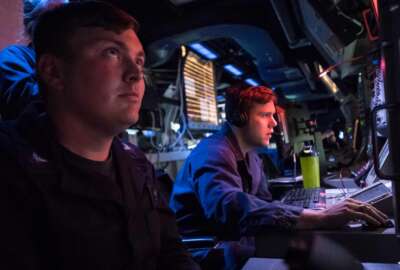

With new OTA for information warfare, the Navy hopes to quickly push its cyber demands to industry, but also get answers to questions it hadn't thought to ask.
To listen to On DoD on your phone or mobile device, subscribe on PodcastOne or Apple Podcasts. The best listening experience on desktop can be found using Chrome, Firefox or Safari.
For the Navy, a new $100 million other transaction agreement focusing on information warfare isn’t just a way to turn government requirements into prototypes and fielded products at a faster clip than is possible under traditional procurement regulations.
It is that, but the Space and Naval Warfare Systems Command (SPAWAR) sees the value of the Information Warfare Research Project (IWRP) in its potential to induce companies to answer questions it hadn’t even thought to ask at the same time it’s asking firms to solve specific, discrete R&D problems.
“If you set this up right, you can encourage unsolicited suggestions for technology advancements,” said William Deligne, the deputy executive director of SPAWAR’s Systems Center Atlantic, the organization that created and is managing the IWRP OTA. “You don’t always know what you don’t know, right? And so what we’re trying to do is encourage a two-way exchange. We’re going to place orders into the consortium, but we want the consortium members to also feel like they can bring unsolicited research to the table that we could consider.”
That consortium is still taking shape. The agreement SSC Atlantic signed earlier this month tasks a management firm, Advanced Technology International, with assembling a collection of both non-traditional and traditional Defense vendors with expertise in 14 IT and cyber-related topics to respond to the Navy’s needs for new R&D.
IWRP’s subject matter ranges from cyber warfare and cloud computing to autonomy and embedded systems. SPAWAR expects to start issuing calls for companies to submit white papers as part of the streamlined OTA process as soon as August.
Initially, officials are aiming to turn those “problem statements” into formal, funded research projects 60 to 90 days after they are first issued.
In most cases, companies who opt to join the consortium will be responding to research demands originating from two of the Navy’s acquisition offices: the Program Executive Office for Enterprise Information Systems (PEO-EIS) and the Program Executive Office for Command, Control, Communications, Computers and Intelligence (C4I).
PEO-EIS is especially interested, Deligne told Federal News Radio’s On DoD.
“They are very heavily dependent on commercial industry because they’re responsible for business systems and enterprise resource planning tools, and they see this as a way to get to that nontraditional DoD industrial base and bring in technologies very quickly,” he said. “But there’s going to be a lot of interest out of PEO-C4I as they move through their programs of record as well.”
But apart from the specific capability gaps the Navy has already identified, SPAWAR also wants to use the consortium to attract solutions it hasn’t even thought to ask for, Deligne said.
That ambition is based at least in part on his prior experience with OTAs during a previous job, when Deligne served as the top civilian official at Naval Sea Systems Command. There, NAVSEA made extensive use of another OTA called the National Shipbuilding Research Project (NSRP).
“NSRP had standing panels the different shipbuilders participated in, and they would go out and look at international ship building, commercial shipbuilding, and they would bring things to the Navy and say, ‘Hey, we think that we ought to make an investment in this,’” he said. “Some things panned out, some things didn’t, but that’s a really good model for continuous innovation and for a positioning industry to help you keep pace with advancing technology. And that’s a hard thing to do in the information warfare space.”
But there’s at least one challenge associated with the expectation that industry will bring the Navy unsolicited proposals as part of IWRP. So far, SPAWAR is not quite sure how it will fund them, since they’re not yet associated with any particular program of record and aren’t formally associated with any particular Navy requirement.
“There’s got to be resources there,” Deligne said. “If it’s a need from one of our customers, that’s easy: the money will come in, we’ll place the order and it’ll get paid for. But in the unsolicited part, industry has to see that — there’s money available, otherwise they’re not going to want to play in that domain. We’re working right now on how to do that.”
Deligne said SPAWAR isn’t yet sure how many projects it will assign to the consortium, but hopes to have a firmer grasp on those plans by mid-August.
SSC Atlantic and ATI are planning an industry engagement day in Charleston, South Carolina, on Aug. 13 and officials expect to release IWRP’s first handful of requests for white papers at that event.
Copyright © 2025 Federal News Network. All rights reserved. This website is not intended for users located within the European Economic Area.
Jared Serbu is deputy editor of Federal News Network and reports on the Defense Department’s contracting, legislative, workforce and IT issues.
Follow @jserbuWFED


